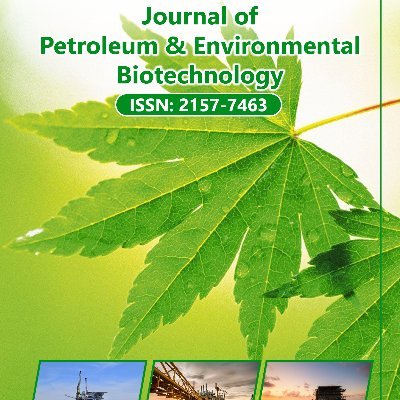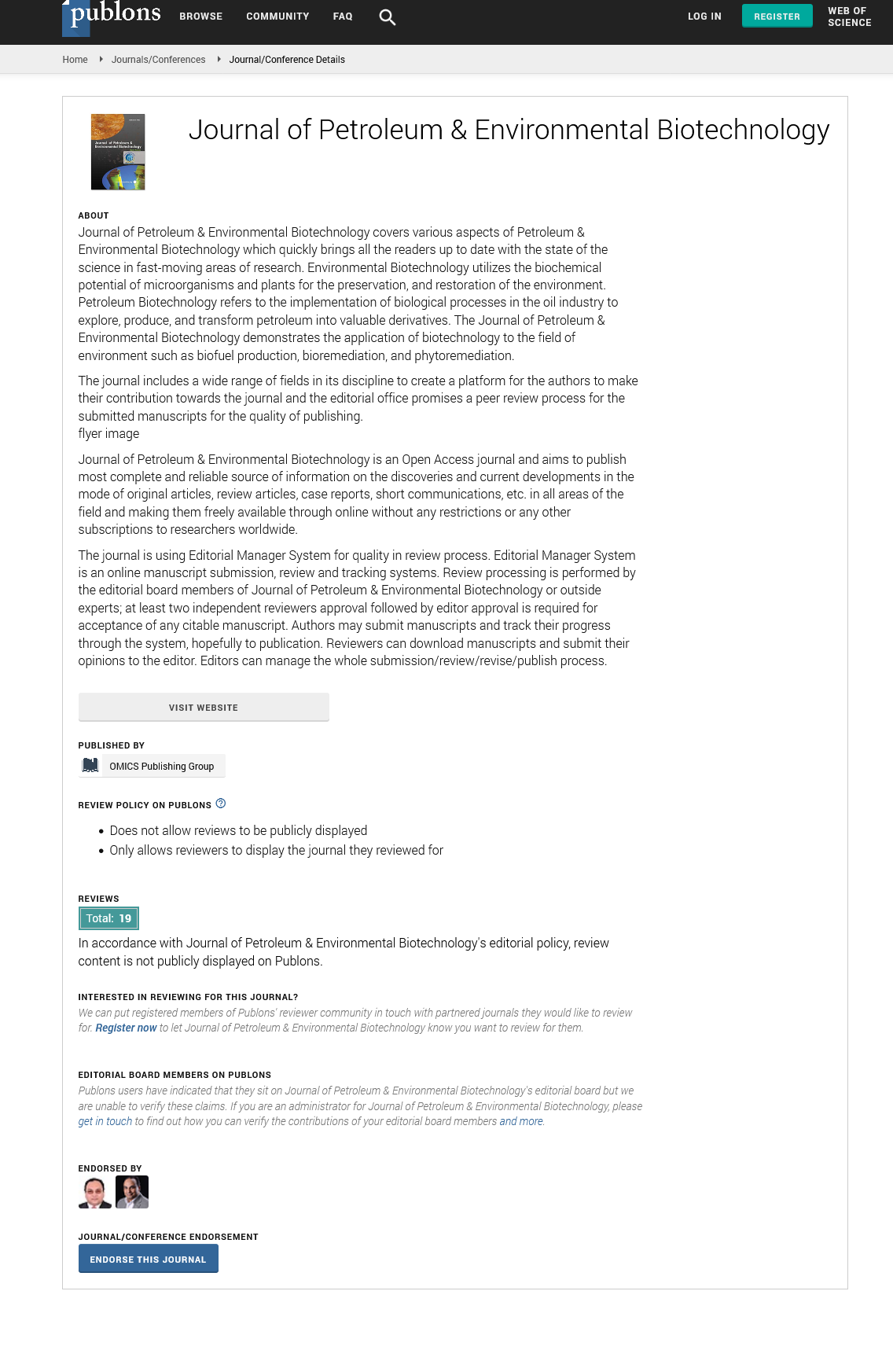Indexed In
- Open J Gate
- Genamics JournalSeek
- JournalTOCs
- China National Knowledge Infrastructure (CNKI)
- Electronic Journals Library
- RefSeek
- Hamdard University
- EBSCO A-Z
- OCLC- WorldCat
- SWB online catalog
- Virtual Library of Biology (vifabio)
- Publons
- MIAR
- Euro Pub
- Google Scholar
Useful Links
Share This Page
Journal Flyer

Open Access Journals
- Agri and Aquaculture
- Biochemistry
- Bioinformatics & Systems Biology
- Business & Management
- Chemistry
- Clinical Sciences
- Engineering
- Food & Nutrition
- General Science
- Genetics & Molecular Biology
- Immunology & Microbiology
- Medical Sciences
- Neuroscience & Psychology
- Nursing & Health Care
- Pharmaceutical Sciences
Commentary - (2024) Volume 15, Issue 2
Environmental Bioreactors: The Dual-Phase Approach to Pollution Management
Frederic Hernandez*Received: 20-May-2024, Manuscript No. JPEB-24-26317; Editor assigned: 22-May-2024, Pre QC No. JPEB-24-26317 (PQ); Reviewed: 05-Jun-2024, QC No. JPEB-24-26317; Revised: 12-Jun-2024, Manuscript No. JPEB-24-26317 (R); Published: 19-Jun-2024, DOI: 10.35248/2157-7463.24.15.572
Description
Two-Phase Partitioning Bioreactors (TPPBs) represent a significant advancement in environmental biotechnology, offering innovative solutions for the bioremediation of contaminated environments and the treatment of industrial effluents. TPPBs utilize a combination of aqueous and non-aqueous phases to enhance the degradation of hydrophobic organic pollutants, providing a controlled environment that optimizes microbial activity and pollutant removal. The dual-phase system offers distinct advantages in handling toxic compounds and improving the overall efficiency of bioreactors, making TPPBs a potential technology for various environmental applications.
The basic principle of a TPPB involves the use of a waterimmiscible organic solvent or polymer as the second phase, which acts as a reservoir for hydrophobic pollutants. This second phase effectively partitions the contaminants from the aqueous phase, where the microbial degradation occurs. By maintaining lower concentrations of the toxic compounds in the aqueous phase, TPPBs minimize the inhibitory effects on microbial activity, thereby enhancing the biodegradation process. This approach allows for the continuous degradation of pollutants that are otherwise difficult to manage in conventional singlephase bioreactors.
One of the primary benefits of TPPBs is their ability to handle high concentrations of hydrophobic organic pollutants without compromising microbial efficiency. In traditional bioreactors, hydrophobic compounds often accumulate on cell membranes, leading to toxicity and reduced microbial activity. TPPBs reduce this issue by sequestering the pollutants in the non-aqueous phase, thereby protecting the microorganisms and maintaining their metabolic activity. This makes TPPBs particularly effective for treating pollutants such as Polycyclic Aromatic Hydrocarbons (PAHs), chlorinated solvents, and various petroleum-derived compounds, which are commonly found in contaminated soils and industrial wastewaters.
The non-aqueous phase in TPPBs serves multiple functions beyond acting as a pollutant reservoir. It can also provide a buffering capacity against fluctuations in pollutant concentrations, stabilize the bioreactor environment, and enable the transport of oxygen and nutrients to the microorganisms. Additionally, the choice of solvent or polymer for the second phase can be personalized to the specific pollutants and microbial communities involved, allowing for customized solutions that maximize degradation efficiency. For instance, hydrophobic polymers like silicone oil and oleophilic solvents like hexadecane are commonly used due to their high affinity for hydrophobic pollutants and compatibility with microbial systems. TPPBs also offer significant advantages in terms of scalability and operational flexibility. The design of TPPBs can be adapted to various reactor configurations, including stirredtank reactors, packed-bed reactors, and fluidized-bed reactors, depending on the specific application and operational requirements. This versatility allows TPPBs to be used in both in-situ and ex-situ bioremediation projects, providing solutions for large-scale environmental cleanups as well as targeted treatment of industrial effluents. Furthermore, TPPBs can be integrated with other treatment technologies, such as physical and chemical methods, to enhance overall treatment efficiency and achieve comprehensive remediation objectives.
In addition to their environmental applications, TPPBs have shown potential in various biotechnological processes, including the production of biofuels, bioplastics, and other value-added biochemicals. The dual-phase system can be utilized to enhance the extraction and recovery of hydrophobic products, improving yield and reducing downstream processing costs. For example, in the production of biodiesel from microalgae, TPPBs can facilitate the extraction of lipids, thereby streamlining the conversion process and increasing overall productivity. Similarly, in the synthesis of bioplastics, TPPBs can help manage the accumulation of hydrophobic intermediates, ensuring a more efficient and sustainable production process. Despite their numerous advantages, the implementation of TPPBs also presents certain challenges that need to be addressed to optimize their performance and ensure widespread adoption. One of the main challenges is the selection of an appropriate non-aqueous phase that is non-toxic, biodegradable, and economically viable. While many solvents and polymers have been studied, finding a material that meets all the criteria for a specific application can be complex and requires extensive research and testing. Additionally, the interaction between the non-aqueous phase and the microbial community must be carefully managed to avoid any adverse effects on microbial growth and activity.
Another challenge is the potential for phase separation and mass transfer limitations, which can impact the efficiency of pollutant degradation. Ensuring effective mixing and contact between the phases is important to maintain optimal conditions for microbial activity. Advances in reactor design, such as the use of immobilized cells, membrane-based systems, and advanced mixing technologies, are being explored to overcome these limitations and enhance the performance of TPPBs. The longterm stability and sustainability of TPPBs also need to be considered, particularly in large-scale and continuous operations. Monitoring and maintaining the integrity of the non-aqueous phase, preventing the accumulation of by-products, and ensuring the resilience of the microbial community are essential for the sustained performance of TPPBs. Implementing robust monitoring and control systems, coupled with regular maintenance and optimization can help address these challenges and ensure the reliable operation of TPPBs over extended periods.
In conclusion, two-phase partitioning bioreactors represent a transformative approach in environmental biotechnology, offering innovative solutions for the bioremediation of hydrophobic organic pollutants and the treatment of industrial effluents. By utilizing the unique properties of a dual-phase system, TPPBs enhance microbial degradation processes, improve pollutant removal efficiency, and provide operational flexibility for a wide range of applications. While challenges remain in optimizing the selection and management of the non-aqueous phase, advances in reactor design and process integration hold potential for the continued development and adoption of TPPBs. As research and technology in this field progress, TPPBs are poised to play an essential role in addressing environmental pollution and advancing sustainable biotechnological processes.
Citation: Hernandez F (2024) Environmental Bioreactors: The Dual-Phase Approach to Pollution Management. J Pet Environ Biotechnol. 15:572.
Copyright: © 2024 Hernandez F. This is an open access article distributed under the terms of the Creative Commons Attribution License, which permits unrestricted use, distribution, and reproduction in any medium, provided the original author and source are credited.

